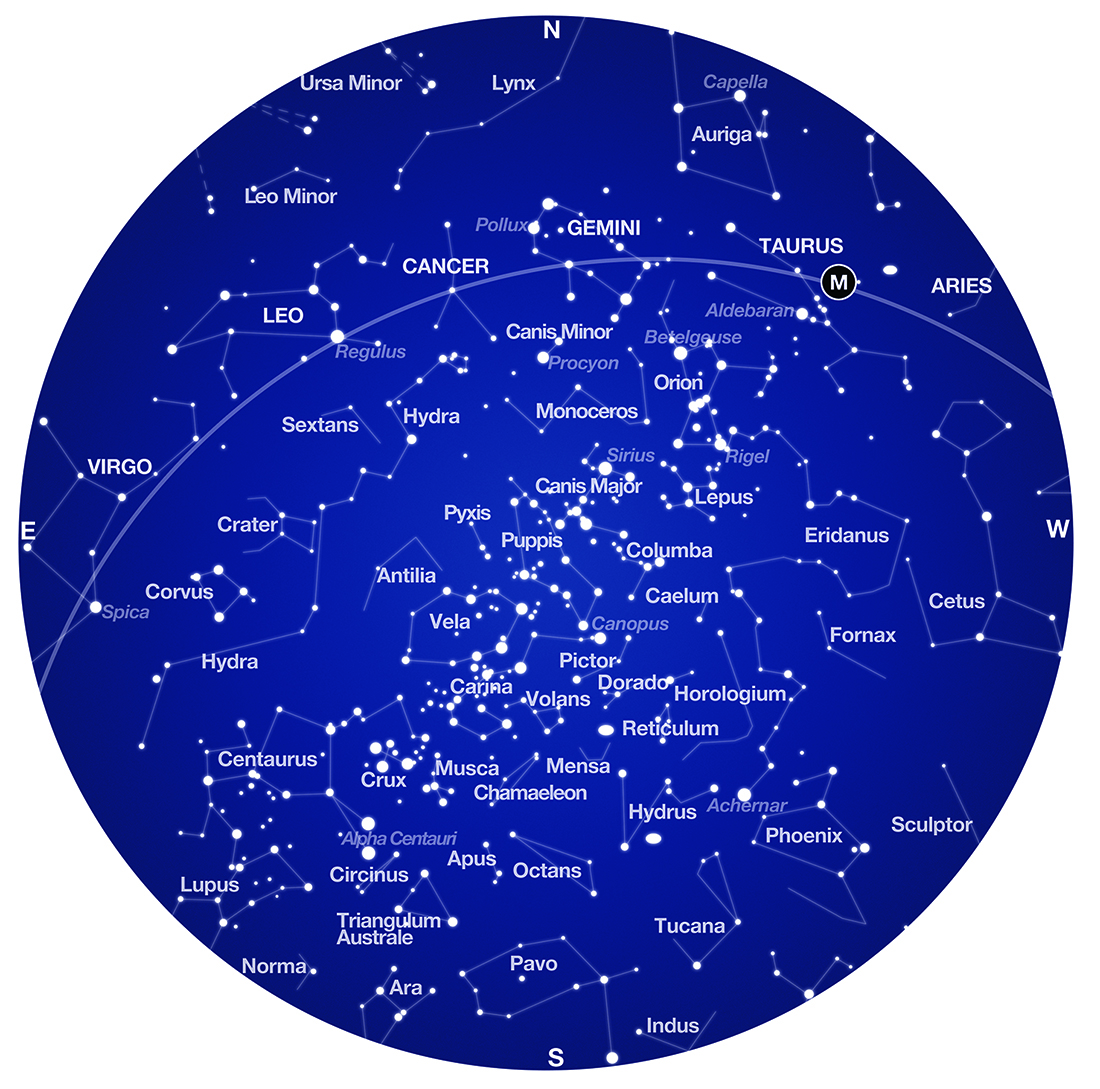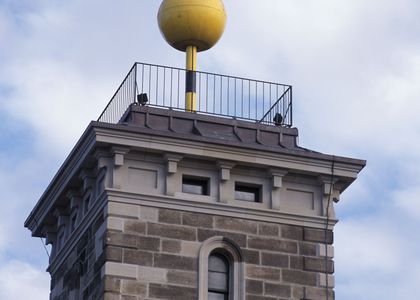
What’s in the sky this March?
Constellations
Constellations represent groups of stars that have been given a name and more recently a border. For millennia they have been used as a tool to share significant cultural stories, events and as markers. Today, the 88 western constellations used here help astronomers map the sky and search for astronomical objects. This March these constellations dominate the autumn sky:
- Taurus – the bull, possibly the oldest of all western constellations, is low in the northwest. It is home to M1 the crab nebula, a star that exploded in 1054 and observed by Chinese astronomers, M45, a striking open cluster and Aldebaran. This is a dying red star 65 light years from the Sun, which in the past was one of the four Royal stars as observed by Persian astronomers. They used it as a marker for the vernal equinox which marked the start of the year until Julius Caesars calendar reform of 46 BCE.
- Orion – the hunter, is descending into March’s north-western sky sitting above Taurus the bull and followed by the faithful Canis Major. One of the most famous non-zodiac constellations, its three-star belt, lies close to the celestial equator. These stars also make the base of what many Australian’s refer to as the base of the saucepan. Within the handle of the saucepan, or the sword for the traditionalists, a star making cloud, or nebula at around 1,350 light years away is one of the first things to look at through a telescope. Known as M42 or the Orion nebula, it contains enough gas and dust to make as many as 2,000 stars like the Sun.
- Leo – the lion, rising in the north-east, looks more like an upside-down question mark in the south for us than a lion as seen from the north. Its brightest star Regulus (Little King) is a system of four tightly bound stars at 79 light years. It was once referred to as one of the four Royal Stars, or guardians of the heavens because of its proximity to the point in the sky that marked the summer solstice as seen by Persian astronomers ~5,000 years ago. Precession of the equinoxes has now moved this point to Cancer the crab.
- Canis Major – high overhead lies the constellation of Canis Major, the greater dog with the brightest star in the night sky, Sirius. A hot white star at just 8.6 light years makes it the 7th closest. Like many constellations, a good imagination, and the ability to ‘see’ stick figure characters will help see the side profile of a dog.
- Crux – Crux or the Southern Cross, the smallest constellation and its pointers of Alpha and Beta Centauri are making their return to the evening sky low in the south-east. Light pollution and the thicker atmosphere near the horizon dims the starlight. They are at their highest and brightest at around 2am, due south. To find south, draw an imaginary line from the top of Crux though the bottom and across the sky to the brightest star in Eridanus, the river, Achernar. This is the least spherical star in the Milky Way with an equatorial bulge of about 50% more than its polar circumference. Halfway along the line, drop to the horizon to find south.
Planets
Mars is the only planet in the evening sky while Mercury, Venus, Jupiter and Saturn are in the early morning sky this month.
- Mars – starts March near the open cluster M45 (Pleaides or Subaru). As its distance from Earth increases, its brightness drops but as the only one visible in the evening as it drifts to the east through the constellation of Taurus, it is still worth a close look. On 19 and 20 March the waxing gibbous Moon passes from west to east of Mars.
- Mercury – is visible low in the early morning eastern sky. It starts the month in Capricornus before moving to Aquarius. On the mornings of 5 and 6 March, it passes within half of one degree of Jupiter. It will be easiest to see on the morning of 6 March with an angular separation from the Sun of 27 degrees (greatest elongation).
- Venus – is too close to the Sun to be seen safely as it passes through Aquarius, Pisces, and Cetus. Venus will be directly opposite the Earth on the far side of the Sun on 26 March (Superior conjunction).
- Jupiter – spends the month in Capricornus. On 11 March, the waning crescent Moon is below Jupiter and above Mercury.
- Saturn – also in Capricornus is close to the waning Moon on 10 March along with Jupiter and Mercury.
Moon
For the monthly movements of the Moon, check out our Moon Phase Calendar.
Equinox
The Autumn equinox, when the Sun crosses from the southern to the northern sky, occurs on 20 March at 8:37pm. On this day, the Sun rises and sets due east and west. The length of day and night is almost equal but not quite.
Deep Sky
Explore the universe through binoculars or a telescope and take in these gems of the March sky:
- The Milky Way – as seen from dark rural locations on a Moonless night is perfect at this time of year around midnight. The faint glow of billions of stars extends from the low southeast across the sky to the northwest. No telescope required and look for the head and neck of the emu in the sky.
- The Great Nebula in Carina – rising high into the southeast, it is more than four times larger than the more famous Orion nebula. Its distance of around 7,500 light years disguises its immense size of around 500 light years in diameter. On a Moonless night it is a stunning view through binoculars or a telescope as well as being visible to the naked eye. It contains some of the youngest star clusters in the Milky Way as well as a star already coming to an explosive death. The star Eta Carinae at 100-150 times the mass of the Sun is a dying cataclysmic variable which is expected to explode as a supernova anytime within the next million years. A supernova precursor eruption in the 1840s temporarily elevated it to the second brightest star in the night sky. This brought it to the attention of Boorong Community of the Wergaia Nation from what is now known as north western Victoria. Please refer to their community Edlers or the local Aboriginal Land Council for more information.
- The small open clusters of NGC 3293 and 3532 both of which are in Carina, are excellent targets for binocular and telescope viewing. NGC 3532 was the first target of the Hubble Space Telescope in 1990. It contains around 150 stars thought to be 300 million years old at a distance of 1,300 light years. NGC 3293 is much younger at 6-20 million years but around 8,000 light years away.
- The Large and Small Magellanic Clouds are two of our Milky Way’s satellite galaxies. The Large Magellanic Cloud (LMC) is in the constellation of Dorado and is about 163,000 light years away, while the Small Magellanic Cloud (SMC) is in Tucana and is about 206,000 light years away. They the brightest in the local group of about 30 nearby galaxies but are best seen away from cities and towns on moonless nights. They look like small parts of the Milky Way that have drifted away but are in fact approaching and are expected to merge with us in around 2.4 billion years.
- Tarantula Nebula (NGC 2070) – is a huge starburst nebula of hydrogen gas approximately 1,000 light years in diameter and 450,000 more massive than the Sun. It sits on the leading edge of the LMC and several young massive stars have already exploded with the cloud.
- M45 the Pleiades or Subaru – one of the more famous open clusters visible to the naked eye, it lies within Taurus. Like all open clusters it is a group of young to middle aged stars. In this case around 100 million years old at a distance of around 444 light years. Many images show the stars associated with a dusty blue nebula however this is between us and the stars. Curiously, these stars are often referred to as seven sisters.
- The Orion nebula (M42) the finest and brightest nebula in the sky, is now descending to the northwest. Sitting close to the celestial equator it is visible to the unaided eye in Orion’s sword from both hemispheres making it one of the first targets for all telescope users. It is approximately 1,344 light years away and 24 light years across. 700 young stars are in various stages of formation with 6 visible in the Trapezium in the heart of the nebula. In simple astrophotography with a DSLR on a tripod it starts to show the pink star making colour of Hydrogen gas but through telescopes and binoculars it is mostly grey-green.
- The two brightest stars at night are now clearly visible overhead in the early evening. Sirius, the dog star in Canis Major, is a binary star just 8.6 light years away. It is twice the mass of the Sun and 25 times brighter. Ancient Egyptians used observations of Sirius to determine the length of the year to be 365 and a quarter days on average. Canopus in the constellation of Carina is 8 times more massive than the Sun and 10,000 times brighter. Its distance of 310 light years drops it to the second brightest star as we see it. Both stars are significant to several Indigenous communities across Australia. Contact Indigenous community Elders or the local Aboriginal Land Council to determine who may be able to share the sky lore of these stars.
- The dying variable red supergiant Betelgeuse in the constellation of Orion in the northwest sky is about 550 light years away and 750 times the size of the Sun. It will eventually explode as a supernova and leave a neutron star behind approximately 1.5 times the mass of the Sun. It is expected to explode sometime in the next 100,000 years…so, keep watching.
Learn More
- Purchase the 2021 Australasian Sky Guide by Dr Nick Lomb, featuring an annual report of what’s in the sky and the latest astronomical findings. Produced by MAAS Media.
- View the March Sky Chart, which shows the stars, constellations and planets visible in the night sky from anywhere in Australia.
- Watch our March Southern Sky Livestream with Sydney Observatory’s astronomy partners on Sydney Observatory’s Facebook.
- Check out these resources for getting started.


